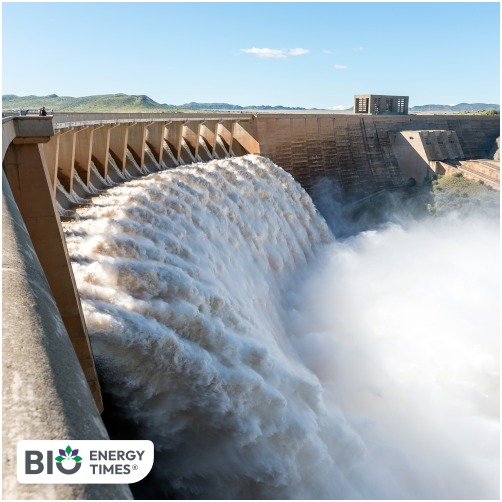Over the past decade, India’s hydropower sector has undergone a subtle but significant revival. Long viewed as slow-moving, risky and constrained by environmental concerns, hydropower has re-emerged as a crucial pillar of the country’s clean-energy architecture—offering flexible generation, peak management and long-duration storage for a grid increasingly powered by solar and wind. India’s large hydro capacity has now reached roughly 50 GW, with multiple long-stalled projects finally breaking through. FY2025-26 alone marked key milestones: Parbati-II (800 MW) entered full commercial service, while the long-delayed Lower Subansiri project (2,000 MW) began wet commissioning.
A Power System That Outgrew Its Assumptions
Between 2015 and 2025, India’s hydro capacity grew only modestly—from the mid-40 GW range to about 50 GW. But the grid around it transformed dramatically. By 2025, total utility-scale capacity reached nearly 500 GW, with 48–50% from non-fossil sources. Even though hydro’s share remained around 10–11%, its strategic value surged, thanks to its ability to provide dispatchable power, peak support, frequency regulation and seasonal balancing in a renewable-heavy system.
A New Focus on Safety and Climate Resilience
Growing awareness of Himalayan climate risks—including glacial lake outburst floods, extreme rainfall and landslides—has reshaped design and safety standards. Enhanced early-warning systems, upgraded dam safety practices and tighter design reviews are now integral to high-altitude projects, strengthening confidence and governance in the hydropower sector.
The Decade’s Defining Projects
Lower Subansiri (2,000 MW)
Located between Assam and Arunachal Pradesh, India’s largest hydropower project has pushed past an eight-year suspension (2011–2019). Key components such as spillway gates, steel liners and mechanical systems are complete, and two 250 MW units entered wet commissioning in October–November 2025. Full commissioning is expected in 2026, providing peaking power to 17 states.
Parbati-II (800 MW)
Now fully operational in Himachal Pradesh, Parbati-II features India’s longest head race tunnel (31.6 km) and record-setting inclined pressure shafts built with Tunnel Boring Machines—underscoring major advances in India’s underground engineering capabilities.
Pakal Dul, Teesta VI and the Chenab Cascade
- Pakal Dul (1,000 MW): Dual long head race tunnels and multiple TBMs are helping navigate complex Himalayan geology. L&T commissioned its second TBM in April 2024. Completion is expected after 2027.
- Teesta VI (500 MW): Revival progressed through June 2025, with 11,000 m of tunnel excavation achieved and 6,000 m of lining completed.
- Chenab cluster: The Kiru (624 MW) and Kwar (540 MW) projects, executed by Patel Engineering, advanced steadily, strengthening a strategically vital hydropower corridor.
Conventional Hydro’s Second Wave
India is preparing for another major build-out in large hydro:
- J&K: Sawalkote (1,856 MW) and Kirthai (930 MW) are primed for construction; Kiru, Kwar and Pakal Dul are nearing commissioning.
- East: The Teesta basin is seeing renewed activity, including plans for Teesta-IV and expansions of Teesta-V and VI.
- Arunachal Pradesh: Major projects such as Kamala (1,720 MW), Subansiri Upper (1,605 MW) and Dibang (2,880 MW) are progressing through approval stages. The state holds more than 50 GW of untapped potential.
- Uttarakhand: Several new hydropower projects are planned using existing reservoirs.
Collectively, these projects will add tens of gigawatts of firm, dispatchable capacity—crucial for balancing renewable energy.
Pumped Storage Takes Centre Stage
While conventional hydro regains momentum, pumped-storage hydropower (PSH) is emerging as the technology that will define the next decade, functioning as giant “gravity batteries” for the national grid.
Policy Tailwinds
Hydropower projects of 25 MW or more now qualify as renewable, and PSH development is supported through transmission-fee waivers, tariff reforms, viability support and streamlined project-report approvals. India has identified 224 GW of PSH potential and aims to deploy roughly 50 GW by 2032. Annual additions are expected to rise from around 3 GW (2025–27) to 10–13 GW per year after FY2028-29.
A Record-Breaking Pipeline
By May 2025, 125 PSH projects totalling about 151.7 GW were in the environmental-clearance process. However, only around 13% had secured clearances or entered construction—highlighting both the scale of ambition and the pressure to accelerate execution.
PSH in Operation
On May 30, 2024, when India’s power demand peaked at 249.8 GW, hydro generation was strategically conserved for the evening peak—illustrating how conventional hydro and PSH together stabilise a renewable-heavy grid.
Capacity Constraints: The Sector’s Bottleneck
Larsen & Toubro (L&T)
L&T is undertaking deep-tunnelling work at Pakal Dul with two TBMs and executing civil EPC work for JSW’s Bhavali PSH project (1.5 GW), including reservoir creation and underground powerhouses.
Patel Engineering
A major hydropower specialist, Patel Engineering is advancing NEEPCO’s HEO (240 MW) civil package, modifying NHPC’s Teesta V spillway, and delivering major components of Subansiri, Kiru, Kwar and the powerhouse package at the 2,880 MW Dibang project.
With only a few capable contractors in the sector, both companies stand to benefit from the surge in PSH and high-head hydropower development.
Managing Sector Risks
- Climate risks: Standardised GLOF modelling, early-warning systems and dam-safety audits for Himalayan sites.
- Permitting delays: Faster DPR approvals and better downstream-impact evaluation frameworks.
- Execution challenges: Scaling TBM usage, specialised manpower, hydromechanical manufacturing and concrete capacity to meet the 50 GW PSH target.
The Road Ahead: Hydropower as India’s Flexibility Backbone
Conventional hydro will continue to add essential peaking and multi-season balancing capacity, with Subansiri (2026), the Chenab cascade and the Teesta basin playing key roles in regional grid stability. But the bigger story is the rapid rise of pumped storage—set to add 10–13 GW annually after 2027 and reach around 50 GW by 2032.
For investors, three metrics will define the sector’s trajectory:
- Annual PSH capacity additions
- Timely delivery of climate-resilient Himalayan projects
- Market mechanisms that reward flexibility and capacity
















